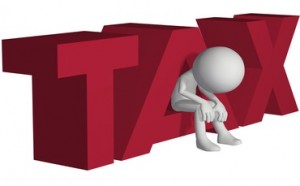In this blog post, Pritishree Dash, a student, pursuing her fourth year LLB at National University of Advanced Legal Studies, Kochi and a Diploma in Entrepreneurship Administration and Business Laws from NUJS, Kolkata, discusses the responsibilities of employers concerning tax filing of employees
Introduction
The Income Tax Act has made the income of a person chargeable to tax. The employer is responsible for the payment of Tax Deducted at Source (TDS) on the salary that is paid to the employees whose annual salaries are above the maximum amount exempted from tax.
Persons Responsible for Paying
Section 204(i) of the Act mentions “persons responsible for paying” which means the employer himself or if the employer is a Company, the Company itself including the Principal Officer. Section 2(35) of the Income Tax Act has specified principal officer to mean:
- Secretary, Treasurer, Manager or agent of the company.
- Any person connected with the management or administration of the company or upon whom the assessing officer has served the notice of his intention to treat him as a principal officer.[1]
The DDO, responsible for crediting, or as the case may be, paying such sum is the “persons responsible for paying” as per Section 204(iv), in the case of credit, or as the case may be, if the payment is by or on behalf of Central Government or State Government or PSUs.
Process of TDS
Although there are many ways of a tax deduction, Tax Deduction at Source aims at taxation at the very source of income. It is essentially an indirect method of “collecting tax which combines the concepts of pay as you earn” and “collect as it is being earned.”[2] While for the taxpayer this is a convenient and hassle-free form of tax payment, for the Government it’s a regular source of revenue.
Every person responsible for paying any income which is chargeable under the head ‘salary’ shall deduct income-tax on the estimated income of the assessee under the heading salaries.[3] The tax is required to be calculated at the average rate of income tax by the rates that are given by the Government at that point of time, and the tax shall be deducted at the time of each payment. Tax on salaries won’t be deducted unless they exceed the maximum amount not chargeable to tax (Rs. 2,00,000/- or Rs.2,50,000/- or Rs. 5,00,000/-, that varies with the age of the employee). The employer is required to deposit the same with the government within the prescribed time. Later, a certificate of deduction of tax at source (Form No.16 or Form 16AA) is to be issued to the employee. Finally, the employer/deductor is required to prepare and file quarterly statements in Form No.24Q with the Income-tax Department. Sub-Section 2 of Section 192 provides that where a person has more than one employer, he may furnish the particulars of salary payments and TDS to the employer of his choice.[4]
TDS Amount
As per Section 192, the employer is required to deduct tax at source on the amount payable at the average rate of income tax. Thus, the employer is required to compute the total salary income payable to an employee during the financial year in the beginning. After considering the incomes exempt, the tax liability of the employee should be determined by the rates as applicable in a given year. Every month, 1/12 of this net tax liability, as computed above, is required to be deducted from the employee’s salary. An Education and Higher Education Cess of 3% on the income tax is levied on the income tax.
The employer may, at his option, make payment of the tax on non-monetary perquisites given to an employee himself without making any TDS from the salary of the employee under Sections 192 (1A) & 192 (1B) of the Income Tax Act. The employer will have to pay this at the same time when he pays income chargeable under the head “salaries” to the employee. The employer has a right to adjust any shortfalls or excess in the deduction of tax already made.
The deductor is also required to deposit the tax so deducted in Government account within the prescribed time and format as per Section 200 of the IT Act. The tax has to be deposited to the credit of the Central Government in any of the branches of RBI, SBI or any authorized bank either in cheque or cash or draft drawn on local banks.[5]
Every deductor is required to furnish a certificate to the employee to the effect that tax has been deducted along with certain other particulars. In a case of employees receiving the salary, the certificate has to be issued in form No.16. Form 26AS shows the amount of TDS, which has been deducted and is available as a credit against our Income Tax liability if any and has to be furnished by the income tax authority.
A return of TDS is a comprehensive statement containing details of salary paid and taxes deducted thereon from the employees along with other prescribed details.[6] It is mandatory to file a return as it certifies that the tax has been deducted and has been paid along with all other details. Such a return was to be prepared and signed by the DDO or the prescribed officer in a case of a government office, the managing partner/partners in the case of a firm or the principal officer in the case of every company, etc.
T.A.N. or Tax Deduction and Collection Account Number is a unique number allotted to the deductor/collector of tax at source for the purpose of identification of every deductor. The deductor has a responsibility to quote TAN in various challans and certificates. The deductor is responsible for quoting the PAN of the employee as well.
TDS Under the Head Salary or Income Other Than Salaries
Estimation of tax on salary and deduction of tax is the responsibility of the employer.  For that, the employer is required to fix the salary payable and accordingly determine the tax liability. The employer is required to compute the gross salary and then deduct the amount that is exempt from taxation. Deductions are made according to S. 16 to arrive at the net salary payable. Salary received from partnership or business; as MP or MLA and family pension.
For that, the employer is required to fix the salary payable and accordingly determine the tax liability. The employer is required to compute the gross salary and then deduct the amount that is exempt from taxation. Deductions are made according to S. 16 to arrive at the net salary payable. Salary received from partnership or business; as MP or MLA and family pension.
An employee may have other income chargeable to tax such as interest income, capital gains and income from house property, etc. Subsection 2B of Section 192 enables the employee to furnish particulars of such income and any TDS thereon to the employer/drawing & disbursing officer. The person responsible for making payments shall take such income and the loss, if any, under the head income from house property into account for the purpose of computing tax-deductible under S 192.
Penalties
Where the employer has failed to deduct tax, he is liable to pay interest.  Where the employer has deducted the tax at source but failed to deposit wholly or partly, he is an assessee in default and liable to pay interest. In the case of Yashpal Sahni v. Assistant Commissioner[7], The court said it was the employer’s responsibility towards employees to deduct the applicable tax at source on their income at the applicable rates, and where the tax was deductible at source, the taxpayer shall not be called upon to pay the amount himself to the extent of deduction. But if the employees’ total income exceeds the maximum amount not chargeable to tax and the employer is deducting no TDS, then the employee is under an obligation to pay tax through the advance tax route.[8]
Where the employer has deducted the tax at source but failed to deposit wholly or partly, he is an assessee in default and liable to pay interest. In the case of Yashpal Sahni v. Assistant Commissioner[7], The court said it was the employer’s responsibility towards employees to deduct the applicable tax at source on their income at the applicable rates, and where the tax was deductible at source, the taxpayer shall not be called upon to pay the amount himself to the extent of deduction. But if the employees’ total income exceeds the maximum amount not chargeable to tax and the employer is deducting no TDS, then the employee is under an obligation to pay tax through the advance tax route.[8]
[divider]
References:
[1] Tds On Salaries, Income Tax Department, available at http://www.incometaxindia.gov.in/booklets%20%20pamphlets/tds-on-salaries.pdf
[3] Section 192 of the I.T.Act, 1961
[4] Supra, note 1.
[5] Supra, note 1.
[6] Ibid.
[7] 2007 (109) Bom L-R 1537.
[8] http://taxguru.in/income-tax/tds-on-salary-employees-responsibility-if-employer-defaults.html
 Serato DJ Crack 2025Serato DJ PRO Crack
Serato DJ Crack 2025Serato DJ PRO Crack









 Allow notifications
Allow notifications



